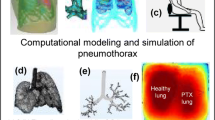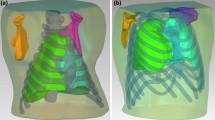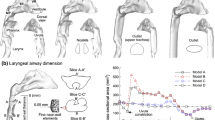Abstract
Many pulmonary injuries and pathologies may lead to structural and functional changes in the lungs resulting in measurable sound transmission changes on the chest surface. Additionally, noninvasive imaging of externally driven mechanical wave motion in the chest (e.g., using magnetic resonance elastography) can provide information about lung structural property changes and, hence, may be of diagnostic value. In the present study, a comprehensive computational simulation (in silico) model was developed to simulate sound wave propagation in the airways, lung, and chest wall under normal and pneumothorax conditions. Experiments were carried out to validate the model. Here, sound waves with frequency content from 50 to 700 Hz were introduced into airways of five porcine subjects via an endotracheal tube, and transmitted waves were measured by scanning laser Doppler vibrometry at the chest wall surface. The computational model predictions of decreased sound transmission with pneumothorax were consistent with experimental measurements. The in silico model can also be used to visualize wave propagation inside and on the chest wall surface for other pulmonary pathologies, which may help in developing and interpreting diagnostic procedures that utilize sound and vibration.








Similar content being viewed by others
References
Armstrong J, Gluck E, Crapo R (1982) Lung tissue volume estimated by simultaneous radiographic and helium dilution methods. Thorax 37(9):676–679
Bergstresser T, Ofengeim D, Vyshedskiy A et al (2002) Sound transmission in the lung as a function of lung volume. J Appl Physiol 93:667–674
Biot MA (1956) Theory of propagation of elastic waves in a fluid-saturated porous solid. I. low-frequency range. J Acoust Soc Am 28:168
Biot MA (1956) Theory of Propagation of Elastic Waves in a Fluid-Saturated Porous Solid. II. Higher Frequency Range. J Acoust Soc Am 28:179
Böhme HRBH (1972) Variable low-frequency sound conduction of the lung in pulmonary emphysema. Z Gesamte Inn Med 27:765–770
Bourbié T, Coussy O (1987) Acoustics of porous media. Editions TECHNIP
Cowin SC (2001) Bone mechanics handbook, 2nd edn. Gulf Publishing Company, Huston, TX
Dai Z, Peng Y, Henry B et al (2014) A comprehensive computational model of sound transmission through the porcine lung. J Acoust Soc Am 136(3):1419–1429
Dai Z, Peng Y, Mansy HA et al (2014) Comparison of poroviscoelastic models for sound and vibration in the lungs. J Vib Acoust 136:051012
Dai Z, Peng Y, Mansy HA et al (2015) A model of lung parenchyma stress relaxation using fractional viscoelasticity. Med Eng Phys. doi:10.1016/j.medengphy.2015.05.003
Donnerberg RL, Druzgalski CK, Hamlin RL et al (1980) Sound transfer function of the congested canine lung. Br J Dis Chest 74:23–31
DuBois AB, Brody AW, Lewis DH, Burgess BFJ (1956) Oscillation mechanics of lungs and chest in man. J Appl Physiol 8:587–594
Fung Y (1997) Biomechanics: circulation. Springer, New York
Garner E, Lakes R, Lee T et al (2000) Viscoelastic dissipation in compact bone: implications for stress-induced fluid flow in bone. J Biomech Eng 122:166
Goss BC, McGee KP, Ehman EC et al (2006) Magnetic resonance elastography of the lung: technical feasibility. Magn Reson Med 56:1060–1066
Haas C, Best T, Wang Q (2012) In vivo passive mechanical properties of skeletal muscle improve with massage-like loading following eccentric exercise. J Biomech. doi:10.1016/j.jbiomech.2012.08.008
Habib RH, Chalker RB, Suki B, Jackson AC (1994) Airway geometry and wall mechanical properties estimated from subglottal input impedance in humans. J Appl Physiol 77:441–451
Habib RH, Suki B, Bates JH, Jackson AC (1994) Serial distribution of airway mechanical properties in dogs: effects of histamine. J Appl Physiol 77:554–566
Horsfield K, Dart G, Olson DE et al (1971) Models of the human bronchial tree. J Appl Physiol 31:207–217
Horsfield K, Kemp W, Phillips S (1982) An asymmetrical model of the airways of the dog lung. J Appl Physiol 52:21–26
Jahed M, Lai-Fook SJ (1994) Stress wave velocity measured in intact pig lungs with cross-spectral analysis. J Appl Physiol 76:565–571
Jahed M, Lai-Fook SJ, Bhagat PK, Kraman SS (1989) Propagation of stress waves in inflated sheep lungs. J Appl Physiol 66:2675–2680
Kraman SS (1983) Speed of low-frequency sound through lungs of normal men. J Appl Physiol 55:1862–1867
Kraman SS, Austrheim O (1983) Comparison of lung sound and transmitted sound amplitude in normal men. Am Rev Respir Dis 128:451–454
Kraman SS, Bohadana AB (1989) Transmission to the chest of sound introduced at the mouth. J Appl Physiol 66:278–281
Lakes RS, Katz JL, Sternstein SS (1979) Viscoelastic properties of wet cortical bone—I. Torsional and biaxial studies. J Biomech 12:657–678
Li B, You JH, Kim Y-J (2013) Low frequency acoustic energy harvesting using PZT piezoelectric plates in a straight tube resonator. Smart Mater Struct 22:055013
Mahagnah M, Gavriely N (1995) Gas density does not affect pulmonary acoustic transmission in normal men. J Appl Physiol 78:928–937
Mansy HA, Royston TJ, Sandler RH (2001) Acoustic characteristics of air cavities at low audible frequencies with application to pneumoperitoneum detection. Med Biol Eng Comput 39:159–167
Mansy HA, Royston TJ, Balk RA, Sandler RH (2002) Pneumothorax detection using pulmonary acoustic transmission measurements. Med Biol Eng Comput 40:520–525
Mansy HA, BalK RA, Warren WH et al (2015) Pneumothorax effects on pulmonary acoustic transmission. J Appl Physiol. doi:10.1152/japplphysiol.00148.2015
Mariappan YK, Glaser KJ, Hubmayr RD et al (2011) MR elastography of human lung parenchyma: technical development, theoretical modeling and in vivo validation. J Magn Reson Imaging 33:1351–1361
Mow VC, Kuei SC, Lai WM, Armstrong CG (1980) Biphasic creep and stress relaxation of articular cartilage in compression: theory and experiments. J Biomech Eng 102:73
Multiphysics C (2011) Acoustics module user guide version 4.2. User’s manual
Nedel LP, Thalmann D Real time muscle deformations using mass-spring systems. In: Proceedings of computer graphics international (Cat. No.98EX149). IEEE computer society, pp 156–165
Niu Y, Shen W, Stuhmiller JH (2007) Finite element models of rib as an inhomogeneous beam structure under high-speed impacts. Med Eng Phys 29:788–798
Paciej R, Vyshedskiy A, Shane J, Murphy R (2003) Transpulmonary speed of sound input into the supraclavicular space. J Appl Physiol 94:604–611
Panzer MB, Myers BS, Capehart BP, Bass CR (2012) Development of a finite element model for blast brain injury and the effects of CSF cavitation. Ann Biomed Eng 40:1530–1544
Pasterkamp H, Patel S, Wodicka GR (1997) Asymmetry of respiratory sounds and thoracic transmission. Med Biol Eng Comput 35:103–106
Peng Y, Dai Z, Mansy HA et al (2014) Sound transmission in the chest under surface excitation: an experimental and computational study with diagnostic applications. Med Biol Eng Comput 52:695–706
Peng Y, Khavari R, Stewart JN et al (2015) The single-incision sling to treat female stress urinary incontinence: a dynamic computational study of outcomes and risk factors. J Biomech Eng. doi:10.1115/1.4030978
Rice DA (1983) Sound speed in pulmonary parenchyma. J Appl Physiol 54:304–308
Royston T, Acikgoz S (2008) Advances in computational modeling of sound propagation in the lungs and torso with diagnostic applications. In: Biomedical Applications of Vibration and Acoustics in Therapy, Bioeffect and Modeling. ASME Press
Royston TJ, Zhang X, Mansy HA, Sandler RH (2002) Modeling sound transmission through the pulmonary system and chest with application to diagnosis of a collapsed lung. J Acoust Soc Am 111:1931
Royston TJ, Acikgoz S, Ozer MB et al. (2008) Advances in computational modeling of sound propagation in the lungs and torso with diagnostic applications. In: Biomedical Applications of Vibration and Acoustics in Therapy, Bioeffect and Modeling. ASME Press, p 32
Royston TJ, Dai Z, Chaunsali R et al (2011) Estimating material viscoelastic properties based on surface wave measurements: a comparison of techniques and modeling assumptions. J Acoust Soc Am 130:4126–4138
Schanz M (2012) Wave propagation in viscoelastic and poroelastic continua: a boundary element approach. Springer, New York
Schmidt S, Cela C, Singh V, Weiland J (2008) Computational modeling of electromagnetic and thermal effects for a dual-unit retinal prosthesis: inductive telemetry, temperature increase, and current densities in the. Artif, Sight
Siklosi M, Jensen O, Tew R, Logg A (2008) Multiscale modeling of the acoustic properties of lung parenchyma. In: ESAIM Proceedings, pp 78–97
Simon BR (1992) Multiphase poroelastic finite element models for soft tissue structures. Appl Mech Rev 45:191
Simon BR, Liable JP, Pflaster D et al (1996) A poroelastic finite element formulation including transport and swelling in soft tissue structures. J Biomech Eng 118:1
Suki B, Habib RH, Jackson AC (1993) Wave propagation, input impedance, and wall mechanics of the calf trachea from 16 to 1600 Hz. J Appl Physiol 75:2755–2766
Tisi GM, Minh VD, Friedman PJ (1975) In vivo dimensional response of airways of different size to transpulmonary pressure. J Appl Physiol 39:23–29
Van Loocke M, Lyons CG, Simms CK (2008) Viscoelastic properties of passive skeletal muscle in compression: stress-relaxation behaviour and constitutive modelling. J Biomech 41:1555–1566
Von Gierke HE, Oestreicher HL, Franke EK et al (1952) Physics of vibrations in living tissues. J Appl Physiol 4:886–900
Vovk IV, Grinchenko VT, Oleinik VN (1995) Modeling the acoustic properties of the chest and measuring breath sounds. Acoust Phys 41:667–676
Wang Q, Zeng H, Best TM et al (2014) A mechatronic system for quantitative application and assessment of massage-like actions in small animals. Ann Biomed Eng 42:36–49
Wodicka GR, Stevens KN, Golub HL et al (1989) A model of acoustic transmission in the respiratory system. IEEE Trans Biomed Eng 36:925–934
Wodicka GR, DeFrain PD, Kraman SS (1994) Bilateral asymmetry of respiratory acoustic transmission. Med Biol Eng Comput 32:489–494
Yen RT, Fung YC, Ho HH, Butterman G (1986) Speed of stress wave propagation in lung. J Appl Physiol 61:701–705
Yushkevich PA, Piven J, Hazlett HC et al (2006) User-guided 3D active contour segmentation of anatomical structures: significantly improved efficiency and reliability. Neuroimage 31:1116–1128
Acknowledgments
Financial support of the National Institutes of Health (Grant No. EB012142) is acknowledged.
Author information
Authors and Affiliations
Corresponding author
Rights and permissions
About this article
Cite this article
Peng, Y., Dai, Z., Mansy, H.A. et al. Sound transmission in porcine thorax through airway insonification. Med Biol Eng Comput 54, 675–689 (2016). https://doi.org/10.1007/s11517-015-1358-8
Received:
Accepted:
Published:
Issue Date:
DOI: https://doi.org/10.1007/s11517-015-1358-8




